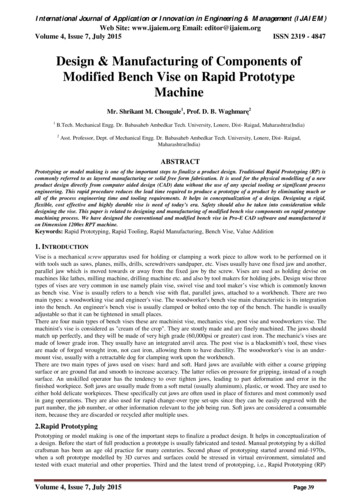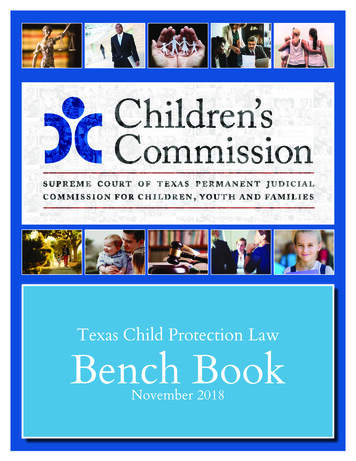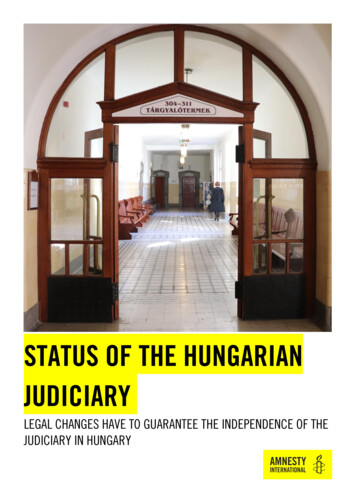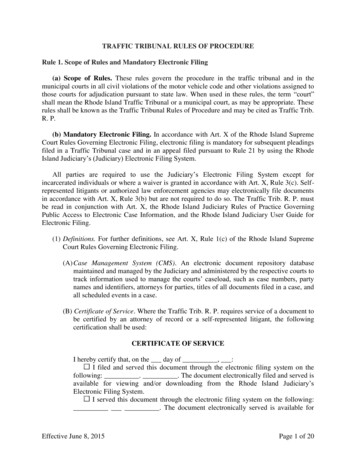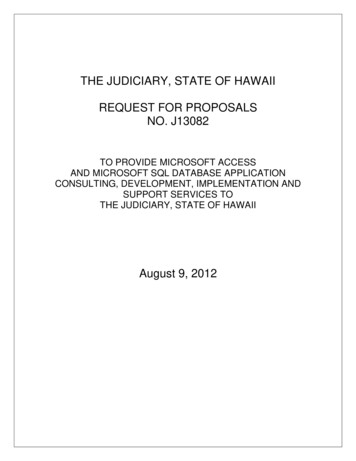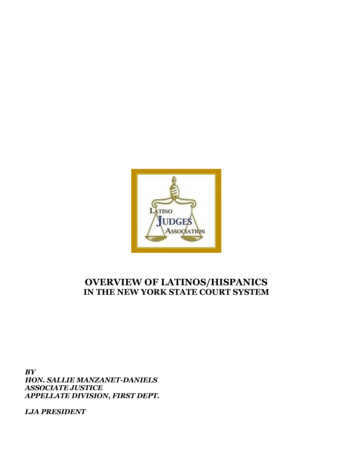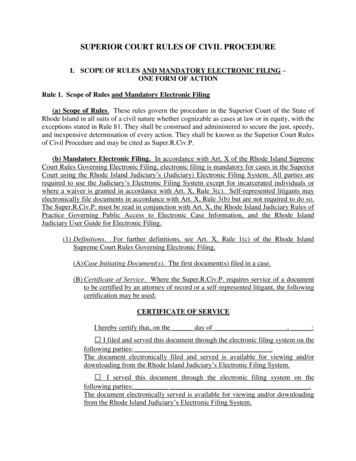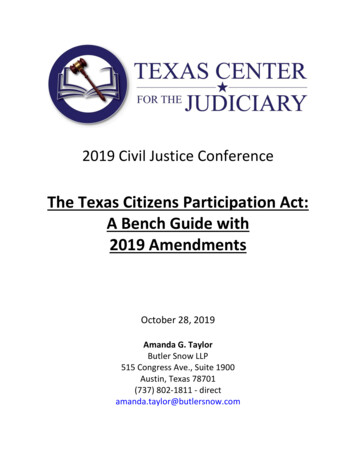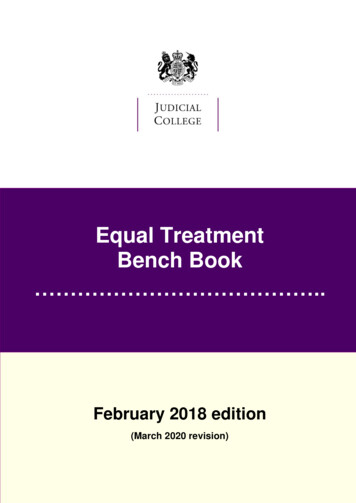
Transcription
Equal TreatmentBench Book .February 2018 edition(March 2020 revision)
ContentsThe Equal Treatment Bench Book is a dynamic document. In the event that youchoose to print or download it, please be aware that it is subject to modification andimprovement from time to time. The most recent amendments to the February 2018edition were made in March 2020 but this was not a full revision.ContentsForeword .1Acknowledgments .2Introduction: Equal Treatment and the Judge .3Introduction . 3Good communication . 4Demonstrating fairness . 5Diversity . 6A note on terminology . 6Chapter 1 Litigants in Person and Lay Representatives .7Contents . 7Overview . 8Litigants in person (‘LIPs’) . 10The courts’ duty to litigants in person . 11Difficulties faced by LIPs . 11Ways to help . 12Holding the confidence of both sides . 12Sources of outside help and information for LIPs . 13Particular areas of difficulty . 13Language . 13Disability . 13Social and educational background . 14Common procedural misunderstandings in case preparation . 14Statements of case / Pleadings and limitation periods . 14Case management: understanding directions and court orders . 14Disclosure of documents . 18Understanding the importance of documentary evidence . 18Trial bundles . 19Witnesses and witness statements . 19Equal Treatment Bench Booki
ContentsAdjournments . 20Sources of law. 21Compromise . 21Difficulties at the hearing and how to help . 22Introductory explanations by the judge . 22The real issues of the case . 23Advocacy . 23Giving judgment . 24Criminal cases . 24Useful guidance materials . 24Guilty pleas . 24The value of representation . 25Assistance during the trial . 25Assistance and representation from lay representatives . 26Overview . 26‘McKenzie Friends’ . 26Support Through Court & Citizens Advice Bureau . 31Rights of audience . 31Small Claims . 35Housing Authority Officers and Employees of Arm’s Length ManagementOrganisations [ALMOs] . 35Companies . 36Official Receivers . 36European lawyers . 36Official Solicitor . 36Representing adults who lack capacity . 36References and resources . 37References . 37Other . 37Chapter 2 Children, Young People and Vulnerable Adults .38Contents . 38Overview . 39Who is covered by this chapter? . 42The rights of young and vulnerable witnesses to effective participation . 42Vulnerability of young and adult offenders . 44Equal Treatment Bench Bookii
ContentsThe duty to safeguard children and vulnerable adults . 45Safeguarding generally . 45Safeguarding in courts and tribunals . 45The judiciary’s role in safeguarding . 46Competence . 47Requirements to take a flexible approach . 48Expedited time-scales and active case management . 50Rules and materials . 50Timetabling . 50Avoiding adjournments . 52Scheduling a ‘clean start’ to witness testimony . 52Special measures and related adjustments . 54Special measures. 54Disapplying special measures . 55Avoiding confrontation. 55Screens . 55Evidence by live link . 55Refreshing witness memory . 57Intermediaries: facilitating complete, coherent and accurate communication . 58The function . 58Should an intermediary be appointed? . 60If the application is contested . 60If the intermediary is not available on the day . 61Intermediaries in family cases . 61Non-registered intermediaries for vulnerable defendants in criminalproceedings . 62Sources of other information about intermediaries . 63Communication aids recommended by intermediaries . 63Ground rules hearings . 63Function of ground rules hearings . 63Topics for discussion at a ground rules hearing . 64Trial practice note of boundaries . 65Sources of other information on ground rules hearings . 65Adjustments to cross-examination . 66The court’s duty to control questioning. 66Equal Treatment Bench Bookiii
ContentsLimiting the length of cross-examination . 67Questioning techniques to avoid . 67Questions about third party material . 69Reporting restrictions . 69Communicating at trial . 70Before the vulnerable person gives evidence . 70Simplified instructions from the judge or magistrate . 71While the vulnerable person is giving evidence . 71Information for the jury . 72Further examples of a flexible approach (disability) . 73The importance of routine feedback . 74References and resources . 74References . 74The Advocate’s Gateway . 75Cases . 76Conventions . 76Chapter 3 Physical Disability . 77Contents . 77Overview . 78What is physical disability? . 80Why this chapter matters . 80Difficulties the court process may pose for disabled people . 81Identifying an individual’s needs . 82Necessary advance planning . 82Consultation, case management and ground rules hearings . 83Adjustments for case preparation . 83Adjustments for the hearing . 84General examples of adjustment. 84Breaks and shorter hours . 86Communication . 86Representation . 87What if the individual does not raise the subject of disability? . 87Criminal court procedure – statutory measures . 87Jury service and disability . 88Acceptable terminology . 89Equal Treatment Bench Bookiv
ContentsHow to discuss someone’s possible needs in court . 89The social model v the medical model of disability. 89Use of terms . 90The legal definition of ‘disability’ . 91References and resources . 91References . 91Cases . 91Conventions . 91Chapter 4 Mental Disability . 92Contents . 92Overview . 93What is mental disability? . 97Prevalence of mental health difficulties . 97Why this chapter matters . 98Difficulties the court process may pose for mentally disabled people . 99Identifying an individual’s needs . 100Necessary advance planning . 100Consultation, case management and ground rules hearings . 101Adjustments for case preparation . 101Adjustments for the hearing . 103General examples of adjustment. 103Breaks and shorter hours . 104Communication . 105Representation . 107What if the individual does not raise the subject of disability? . 107Criminal court procedure – statutory measures . 108Mental health: defendants and the criminal justice system . 109Prisoners and mental health . 109Ways to find out whether the defendant has a mental health condition . 110Mental Health Liaison and Diversion Services . 110Bail and remand decisions . 111The trial . 111Sentencing . 111Veterans . 113Mental health. 113Equal Treatment Bench Bookv
ContentsThe cause of veterans’ mental health difficulties . 113Veterans and the criminal justice system . 114The Armed Forces Covenant . 115Acceptable terminology . 115How to discuss someone’s possible needs in court . 115The social model v the medical model of disability. 115Use of terms . 116The legal definition of ‘disability’ . 116The Equality Act 2010 . 117References and resources . 117References . 117Cases . 118Conventions . 118Chapter 5 Capacity (Mental) . 119Contents . 119Overview . 120Criteria for assessing capacity . 121The approach of different professions . 121Assessment of capacity . 122Presumption of capacity . 122Determining capacity. 122Evidence . 123Implications . 123Guidance . 124The Mental Capacity Act 2005 (MCA) . 124Background and overview . 124Fundamental principles . 125The concept of ‘incapacity’ under the MCA . 125The concept of ‘best interests’ under the MCA . 125Decision-making. 126The public bodies created by the MCA . 126The jurisdiction under the MCA . 127Civil and family proceedings – procedure . 127The procedural rules . 127Protected party . 128Equal Treatment Bench Bookvi
ContentsAssessment of capacity . 128A protected party’s representative (litigation friend) . 129Procedural consequences of being a protected party . 130Injunctions . 131Litigation friends in tribunals . 131References and resources . 131Chapter 6 Gender . 133Contents . 133Overview . 134Gender disadvantage and stereotyping . 137Employment . 137Employment rates . 137The Gender Pay Gap . 137BAME women in employment . 138Caring . 138Carers of children . 138Caring for elderly and disabled dependants . 139Accommodating different sitting hours and breaks. 139Pregnancy, maternity leave and breastfeeding . 139Discrimination at work . 139Adjustments for pregnant or breastfeeding women in courts and tribunals . 140Sexual harassment . 140Domestic violence and abuse . 141Domestic violence . 141Coercive Control . 142Female Genital Mutilation . 144Sexual offences . 144Who is affected? . 144Directing the jury . 145Ensuring safe participation in the judicial process . 145Social media . 146Women as offenders. 148Who is in prison?. 148The impact of imprisonment on women . 149Dependants and primary carers . 151Equal Treatment Bench Bookvii
ContentsBAME women offenders . 152Guidelines and standards for the treatment of women offenders . 153Marriage and divorce . 153Acceptable terminology . 154The Equality Act 2010 . 155References and resources . 155Chapter 7 Modern Slavery . 157Contents . 157Overview . 158What is modern slavery? . 159Protection of victims and compensation . 159Help with court process . 160References and resources . 161Chapter 8 Racism, Cultural/Ethnic Differences Antisemitismand Islamophobia . 162Contents . 162Overview . 163Avoiding stereotypes and holding confidence . 167Social and economic inequality. 167Introduction . 167Education . 168Adult literacy . 169Employment and earnings . 169Poverty . 170Health. 170Gypsies, Travellers and Roma. 171Help with the court process . 172Migrants, refugees and asylum-seekers . 173Definitions and overview . 173Vulnerability and mental health issues . 174Help with the court process . 175Communicating interculturally . 175Communication with witnesses from di
Equal Treatment Bench Book i The Equal Treatment Bench Book is a dynamic document. In the event that you choose to print or download it, please be aware that it is subject to modification and improvement from time to time. The most recent amendments to the February 2018 edition were made in March 2020 but this was not a full revision. Contents
